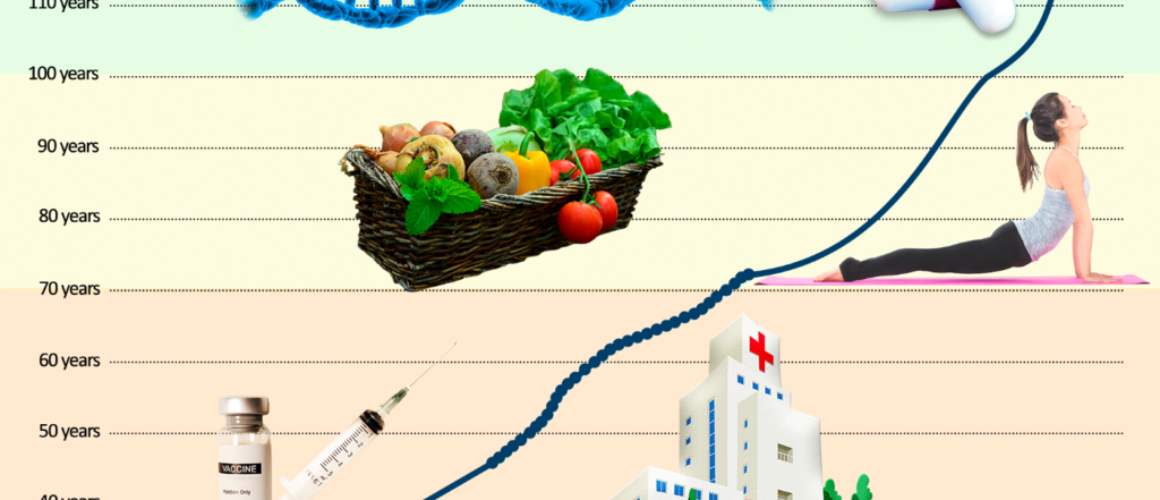The Path to Greater Life Efficiency
Finding health and happiness in a smaller ecological footprint

Here’s an interesting question: If we could get everyone fully invested in one metric of individual success, which metric would do the greatest good?
To me, it would have to be “Life Efficiency,” conveniently estimated using this new online calculator.
Simply put, your Life Efficiency is the number of happy and healthy life years you gain from each dollar of daily spending. It’s built on two basic truths:
- We all want happy and healthy lives
- The world has a finite amount of productive and ecological capacity for supporting the health and happiness of 8 billion people
As estimated in a previous article, the average rich-world citizen could boost their Life Efficiency by as much as 500% relative to today’s level. In other words, we’re consuming a massive amount of effort and resources for relatively poor returns in health and happiness.
Given that around 6 billion world citizens remain below decent living standards, such waste cannot continue. We must do better.

But how should we go about it? Grudgingly give up the things we love for the sake of the natural world and poor communities in faraway countries?
No, that would never work. The human race will always strive for better lives. But there is a solution: We can leverage the intelligent curtailment of wasteful spending as a springboard to happier, healthier, and more productive lives. That’s what Life Efficiency is all about.
The paradigm of building a good life on the foundation of sustainable consumption leads to an intriguing list of interconnected best practices. Let’s take a tour through the list of seven proven pathways to a more Efficient Life.
1. Remember: The Best Things in Life are Free
It’s an old cliche but so very true. Many of the things that give human beings the greatest happiness and the longest lives don’t cost a thing. Sadly, we’ve been losing touch with these basic sources of fulfillment recently, seduced by the instant gratification of social media feeds and all the (mostly useless) stuff their personalized advertising algorithms tell us we need.
Efficient Living requires that we find our way back. Here are some proven paths to health and happiness you can access for free.
Prioritize relationships
Humans are social creatures. It’s hardwired into our beings through millennia of evolution. Thus, even though vegging out in front of Netflix by yourself is far easier, quality relationships will give you far greater health and happiness.
You don’t need many relationships, but you do need a few good ones. Thus, take special care of those dearest to you. Make time for them, and make sure you are 100% present during that time. Aside from the obvious direct benefits of being part of a loving family, the age-old biochemical responses of your body will reward you with a lasting sense of wellbeing.
Get into nature
Spending time in the natural world has been scientifically proven to boost our health and wellbeing. And no, you don’t need to book an expensive trip to some exotic jungle. Regular strolls in your local park will do just fine, perhaps augmented with the occasional trip to the closest bit of untouched nature in your vicinity.
Read a book
So, when was the last time you saw the inside of a library? In our age of ubiquitous digital video, chances are that you can’t even remember. Yet, science is uncovering many ways in which reading benefits our wellbeing. It can even help us live longer. So, pick up a good book and break through the little bit of initial resistance required to get into it. From personal experience, reading in nature takes the experience up another notch.
Sleep
Hustle culture makes sleep sound like wasted time when the truth is that it’s one of life’s healthiest and most enjoyable indulgences. The central importance of sleep to human health is clearer than ever, but it should not be viewed as some sort of medicine to be taken out of necessity.
A contented mind on a personal schedule that prioritizes sleep can derive great pleasure from this activity. See what happens when you replace your evening screen-staring session with a warm shower, some gentle music, possibly some slow yoga and/or a guided meditation, and an earlier bedtime. And when sleep occasionally refuses to come, have a good book standing by.
Create
Humans have an innate desire to create. As we’ll get to in Section 6, the ultimate goal is to shape your occupation into a set of creative activities you would happily do for free, but until that time comes, a fun hobby will do.
Subtract before you add
Finally, a heads-up: Don’t try to force these things into an already overcrowded life. First, make space by scaling down the (often self-sabotaging) ways in which you try to buy happiness today. You know, stuff like digital entertainment, sensationalist media, retail therapy, overeating, and other addictive substances.
If your attempts to make a change for the better leave you feeling overwhelmed, you’ll quickly revert back to these instant-pleasure vices. Be very mindful of this threat, and be sure to subtract before you add.
2. Develop a Deep Interest in Your Family’s Health
The internet and the world’s bookstores are filled with quality health advice capable of adding many good years to our lives. Yet, we’re in the midst of a lifestyle disease epidemic — one of the most vicious destroyers of Life Efficiency. Indeed, our unhealthy habits shorten our lives and make us spend massive amounts of money on reactive healthcare, often to accomplish little more than needlessly prolonging intense suffering.

Reversing this terrible global trend holds the key to rapid permanent improvements in Life Efficiency worldwide. Let’s see how it can be done.
The four pillars
The wealth of information at our disposal makes it clear that excellent personal health rest on four pillars:
- Healthy diet: Whole foods, mostly plants, with little or no refined sugar
- Regular exercise: The equivalent of at least 7000 steps per day
- Enough sleep: Giving the body the amount of sleep it naturally demands
- Mild stress: Avoiding the chronic presence of fight-or-flight hormones
There are also more advanced health-promoting practices that stimulate the body’s natural repair mechanisms to extend healthy lifespan. These include fasting, occasional vigorous exercise, and hot/cold exposure.
A self-sustaining interest
Although I have written extensively on the topics of diet, exercise, sleep, and mental health, this article is not the place for details on how these four pillars can be securely planted. Instead, I want to condense matters into two fundamental guiding principles:
- Strive to build an environment where healthy actions happen naturally
- Do all you can to kindle a genuine interest in the field of personal health
Everyone’s situation is unique, so we all need to follow subtly different paths to sustainable healthy living. And the key to finding your own path is to develop a lasting interest in the fascinating challenge of building a healthy environment for yourself and those you care about. Spark this interest, and the rest will take care of itself.
Efficient Living promotes health
As stated earlier, our lifestyle disease epidemic is the very antithesis of Life Efficiency. Thus, it follows that a focus on building an Efficient Life would naturally promote healthy living.
Here, it’s important to understand how unhealthy habits reinforce each other. For example, someone who is stressed or suffering from chronic sleep deprivation is more likely to consume unhealthy food, while those suffering from obesity and other effects of a poor diet are less likely to exercise and more likely to develop self-sustaining mental health problems.
Life Efficiency practices will interrupt such self-sustaining self-destruct cycles by creating a natural environment for more physical activity, better sleep, and better mental wellbeing. And the relationship goes both ways: Enhanced vitality and awareness cultivated by a healthy lifestyle make it easier to build a truly Efficient Life. Activating this virtuous cycle is highly recommended.
3. Forget About the Joneses
Be honest now: How many of the things you own were bought more for their promise of impressing other people than their practical function? Humanity wastes an astounding amount of effort and resources on this phenomenon of “keeping up with the Joneses.”
Trying to prove your worth to the world through the possessions and experiences you buy is pointless. In fact, it’s beyond pointless — an act of spending more money on lower wellbeing.

Don’t fall into this trap. Whether your status symbol of choice is a fancy car, a big house, or anything else, it will give you little other than a big debt burden and an even bigger ecological footprint. It’s not worth it.
4. Location, Location, Location
Everyone knows the three most important things to consider when moving house: location, location, and location. But defining what exactly the ideal location means for you is no simple task. There are so many things to consider that rational prioritization can feel impossible.
But what if you simplify it by locating your home solely for the purpose of maximizing Life Efficiency? Let’s see what that might look like.
Car-free living
The typical car-centered suburban lifestyle is another powerful destroyer of Life Efficiency. Indeed, if the location of your home forces you to spend an hour or two each day trapped inside an expensive metal box, navigating stressful and dangerous traffic, it severely handicaps your ability to build an Efficient Life.

In contrast, a car-free lifestyle where you are intelligently positioned within safe and convenient walking/cycling distance of everything you need will create a large and immediate boost in Life Efficiency. If you have kids, living in a city where they can safely and independently move around strongly enhances the positive effects of this smart lifestyle choice.
Let’s see how car-free living benefits the three components of Life Efficiency:
- Spending: A car is the average consumer’s second-largest expense. Dropping it instantly boosts Life Efficiency and accelerates your journey to the joys of creative freedom (Section 6).
- Health: Travelling by human power instead of fossil power uses the body as it was designed to be used, naturally promoting health. No more need to pay a gym for the privilege of running on a treadmill like a hamster.
- Wellbeing: No more traffic jams, car maintenance hassles, or money problems from car and gasoline payments.
The unfortunate reality is that car-free living remains outright impossible in many cities, but, as the old wisdom goes; seek, and you shall find. The range of options is expanding, and the vast rewards of a car-free lifestyle are well worth some focused seeking.
Access to nature
As mentioned in the first section, spending a good deal of time in the natural world brings a range of benefits. Unfortunately, accessing nature is difficult for most of the world’s growing urban population.
That’s why nature should be high on your list of things that must be within walking/cycling distance of your home. A safe and well-maintained park is good, but untouched nature is even better.
Luckily, the digital age makes it possible for many workers to avoid regular trips to an office or a busy city center. An increasing number of people can now work from a home office and order most of the goods they require online, greatly expanding the number of suitable locations for their next home.

If these possibilities are open to you, give them careful consideration. Yes, being trapped in a home office in a noisy inner city apartment is no fun, but I can attest that a home office in a quiet semi-urban neighborhood with nature in your backyard is pretty much the ideal working and living environment.
Living closer to nature can also cut our greatest expense: housing. Property away from the city center is often cheaper and, more importantly, the possibility to step out into the natural world whenever you want makes it easy to live in a smaller home. Thus, nature presents an excellent avenue for building a better life on the basis of intelligently curtailed spending.
Family
If you have a close bond with your family (or some special friends who feel like family), living in close proximity offers a big Life Efficiency boost. Those with young kids can get a particularly large benefit from having their parents nearby. Grandmothers in particular benefit greatly from regular interaction with their grandkids, and most young parents could really use such free and trusted childcare services.
You might even consider joining the reviving trend of the multi-generation household. Having more people under the same roof is also a great way to reduce spending on housing, the #1 expense for most families.
Inspiration
Finding the Life-Efficiency-enhancing creative flow that flips your mind from consumer mode to creator mode (Section 6) will come more naturally when you live in an inspiring environment. Where that inspiring environment can be found will depend entirely on the type of creative expression that speaks to you, but whatever it is, finding the location that houses the people and places most likely to fuel your creative fire is a great idea.
Peer pressure
Aside from locating your home somewhere that allows car-free living, access to nature, close family ties, and natural inspiration, it would also help to become part of a society that already values health and community over wasteful consumerism.
Living among people who lead relatively Efficient Lives will make it considerably easier to maximize your own Life Efficiency. From my experience, the Nordics offer some good possibilities.
Broaden your horizons
When considering the location of your next home, don’t limit your scope to your current city or even your current country. The world offers an almost infinite range of possibilities, many of which will allow you to build a truly Efficient Life. Spending the time and effort required to find the ideal location for your unique life could be the best investment you ever make.
5. Purposefully Approach Financial Freedom
While wastefully spending money in attempts to buy happiness and status will only harm long-term health and happiness, saving and investing money is a different story. Indeed, wealth appears to be a good predictor of happiness and even life expectancy.
Wealth and financial freedom
Clearly, financial security is an important part of a good life. Money worries can be highly stressful and frustrating. Thus, having a solid rainy-day fund and low debt is an important part of wellbeing.
But far greater life satisfaction awaits as your wealth grows. When your investments eventually start yielding returns comparable to your income, a whole new world of possibility shows itself: the world of financial freedom.
Financial freedom is the point where money no longer needs to have any say in the way you spend your time. Most importantly, you get to work more on things you want to do and less on things you have to do. Furthermore, you get to put your wealth to work in investments that align with your values. All this makes financial freedom a very pleasant place to be.
Automate saving and investment
So, why do so few people enjoy financial freedom? Well, the primary reason is that our consumer economy is designed to generate a constantly growing desire for more stuff. Resisting this pull is the key to building wealth. And the best way to do that is to implement a fully automated plan that invests a gradually increasing sum out of your salary the moment it hits your bank account. It must be like it was never even there.
Once this is set up, the next thing to decide is how much you want to save. As illustrated next, the point at which your investment income covers all your spending needs can come surprisingly soon if you save aggressively.
Pathways to financial freedom
For example, the solid blue line in the following graph shows that, if you keep your savings rate at 10% of your growing income, you will have to keep a steady job for the entirety of a 40-year career and scale down significantly in retirement (unless you get a solid state pension). In this scenario, the passive income from your investments only reaches half your spending by the end of your career.
However, if you manage to keep your real (inflation-adjusted) spending constant, you will reach financial freedom halfway through your career (dashed blue line). This timeline can be accelerated strongly through higher savings rates, as indicated by the orange lines.

Efficient Living promotes wealth
Increasing Life Efficiency is all about boosting health and happiness while reducing spending. Thus, Life Efficiency would naturally increase your savings rate and accelerate your journey toward financial freedom.
And once again, it goes both ways. As we’ll see next, financial freedom can be leveraged to strongly increase Life Efficiency.
6. Free Creative Expression
While an automated investment program will help, the very best (and most enjoyable) protection against wasteful consumption is the freedom to spend your days on creative activities you find naturally inspirational. And here’s the good news: With a focus on Life Efficiency, this ideal is much closer than you might think.
The virtuous cycle
Life Efficiency at work creates a virtuous cycle like the one shown below. The more meaning and enjoyment you get from your work, the less you will be tempted by the advertising industry’s false promises of “happiness through consumption.” This, in turn, accelerates your journey toward financial freedom, which holds the key to a naturally inspirational career.

Sadly, most people are stuck in a vicious cycle going the opposite way: Stressful work leads to more attempts to buy happiness, creating debt burdens and spending habits that trap us in soul-killing jobs. This cycle is another renowned destroyer of Life Efficiency around the world. An escape into the virtuous alternative shown above offers a fundamental solution.
Claiming creative freedom
You don’t need to wait until full financial freedom to claim your creative freedom. In fact, it’s safe to start even when you’re only about 20% there.
The idea is to leverage your growing stream of passive income to gradually shape your work into something you do because you want to, not because you have to. There are two main practical avenues:
- Ramping down your present level of employment, negotiating that you give up your least enjoyable activities in exchange for a lower salary
- Taking a new and more enjoyable job (or even starting your own venture) even though it might pay less
And rest assured: In most cases, the salary you give up will only be temporary because you will naturally create much greater value when working on truly inspirational tasks. More importantly, you won’t even miss the income you temporarily gave up because you’ll be far too busy creating inspirational value to worry about trying to buy happiness.
Taking the first step
Any journey starts with the first step. And this journey’s first step is particularly difficult. I’m sure you can feel deep down that willfully giving up some salary comes about as naturally to us as breathing underwater, even if you fully understand the promise it holds.
But it only takes a few short weeks of discomfort to get this ball rolling. In the context of the rest of your life, these few weeks are well worth it. If done responsibly with the philosophy of Life Efficiency gradually reshaping your spending habits, the risks are small and the potential rewards spectacular.
7. Invest in the Greater Good
As outlined in the previous section, the journey toward free creative expression is a central characteristic of an Efficient Life. This journey marks the life-changing transformation from chasing happiness through consumption to finding lasting purpose in creative expression.
Once this transformation takes hold, we get to enjoy another feature of an Efficient Life: its large productive surpluses.
Creating without immediate reward
While the rest of the world consumes as much (or even more) than they create, those maximizing Life Efficiency will naturally create much more than they consume. The reason is simple: inspired creation is a reward in itself, thereby increasing productive output and reducing the desire to consume.
And that’s where the final test of an Efficient Life emerges: The world rarely offers immediate rewards for truly purposeful work. Instead, it pays those who can satisfy the engineered consumer desires of the masses, often through meaningless “bullshit” jobs.
Thus, truly inspiring work will rarely earn you a large salary. It might even earn no salary at all, implying that the market places no value on your work.
Of course, the market could be right, but if you’re truly inspired by what you are doing, that’s highly unlikely. The far more likely scenario is that the value you are creating targets a long-term problem/opportunity instead of providing the short-term instant-pleasure fixes most consumers demand.
So, don’t be discouraged by a lack of immediate recognition for your efforts. As long as your creative endeavors do not feel like work, you’re on the right track toward a truly Efficient Life.
Practical matters
Of course, we all need to earn a decent living, so it’s important to approach the journey to creative freedom responsibly (Section 6).
Also, keep in mind that, although rare, meaningful well-paying jobs do exist and are well worth searching for. If you ever get the opportunity to earn a good living doing work you would happily do for free, grab it with both hands.
Invest time, money, or both
If the surplus value you create is not being recognized financially, rest assured that your creative time is not being wasted. Your work can only feel truly meaningful if you know deep down that it adds real value to the world. And such work is far more valuable than any high-paying “bullshit” job.
But if you keep delivering real value to society year after year, it is highly likely that the rewards will come. Your growing skill level, social capital, and creative portfolio will keep increasing the likelihood of a breakthrough.
When that time comes (or if you are lucky enough to already have a well-paying and truly meaningful job), you enter that glorious realm where you can freely direct both your time and money. Investing in funds aligned with your values is one possibility, but financial investments in your own creative initiatives offer a far more exciting prospect.
I see this as the ultimate reward offered by a truly Efficient Life, both to the individual and broader society. When you reach the point where you are the master of your own time, and you have full control over a sizable fund to finance your inspiring creative endeavors, Life Efficiency shines at its brightest.
Final Thoughts
There are many intricate connections between the actions covered in the seven sections above. As you steadily progress toward greater Life Efficiency, you will enjoy how they naturally flow into each other, binding together into a self-sustaining whole.
All the actions described in this article are implemented in my own life, and I can honestly say the rewards have been tremendous. This experience gives me hope that Life Efficiency can grow organically on the simple fact that it makes people’s lives (a lot) better.
From such organic growth in Life Efficiency, a more sustainable and equitable society will follow as a natural side-effect. We will simultaneously reduce our negative impacts by curbing wasteful consumption and accelerate our progress on key global challenges through our growing creative surpluses. In other words, Life Efficiency can help us build a healthier world out of millions of happier lives.
Today, all this remains little more than a hypothesis, proven only in a couple of cases. But it has the potential to make a real difference in the world. So, if you found this interesting, please share our new Life Efficiency calculator. It will be very interesting to see where this adventure leads.







